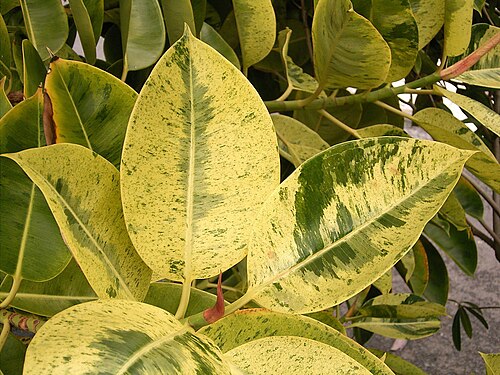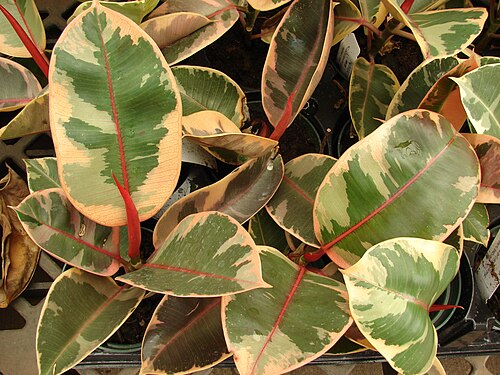Difference between revisions of "Ficus elastica"
| (One intermediate revision by one other user not shown) | |||
| Line 1: | Line 1: | ||
| − | + | {{SPlantbox | |
| − | | | + | |familia=Moraceae |
| − | | | + | |genus=Ficus |
| − | | | + | |species=elastica |
| − | | | + | |habit=tree |
| − | | | + | |habit_ref=Flora - A Gardener's Encyclopedia ISBN 0881925381 |
| − | | | + | |Min ht box=90 |
| − | | | + | |Min ht metric=ft |
| − | | | + | |Max ht box=200 |
| − | | | + | |Max ht metric=ft |
| − | | | + | |height_ref=Flora - A Gardener's Encyclopedia ISBN 0881925381 |
| − | | | + | |Min wd box=70 |
| − | | | + | |Min wd metric=ft |
| − | | | + | |Max wd box=200 |
| − | | | + | |Max wd metric=ft |
| − | | | + | |width_ref=Flora - A Gardener's Encyclopedia ISBN 0881925381 |
| − | | | + | |poisonous=toxic sap |
| − | | | + | |lifespan=perennial |
| − | | | + | |life_ref=Flora - A Gardener's Encyclopedia ISBN 0881925381 |
| − | | | + | |exposure=sun |
| − | | | + | |sun_ref=Flora - A Gardener's Encyclopedia ISBN 0881925381 |
| − | | | + | |Temp Metric=°F |
| − | | | + | |min_zone=11 |
| − | | | + | |usda_ref=Flora - A Gardener's Encyclopedia ISBN 0881925381 |
| − | | | + | |max_zone=12 |
| − | | | + | |image=Ficus elastica1.jpg |
| − | | | + | |image_width=180 |
| − | |||
}} | }} | ||
| + | '''''Ficus elastica''''', also called the '''rubber fig''', '''rubber bush''', '''rubber plant''', or '''Indian rubber bush''' is a species of [[plant]] in the [[ficus|fig]] genus, native to northeast India and southern Indonesia. | ||
| + | |||
| + | It is a fat [[shrub|bush]] in the [[banyan]] group of figs, growing to {{convert|30|-|40|m}} (rarely up to {{convert|60|m|ft|disp=/}}) tall, with a stout trunk up to {{convert|2|m|ft}} diameter. The trunk develops [[Aerial root|aerial]] and [[Buttress roots|buttressing roots]] to anchor it in the soil and help support heavy branches. It has broad shiny oval [[leaf|leaves]] {{convert|10|-|35|cm|in}} long and {{convert|5|-|15|cm|in}} broad; leaf size is largest on young plants (occasionally to {{convert|45|cm|in|disp=/}} long), much smaller on old trees (typically {{convert|10|cm|in|disp=/}} long). The leaves develop inside a sheath at the apical [[meristem]], which grows larger as the new leaf develops. When it is mature, it unfurls and the sheath drops off the plant. Inside the new leaf, another immature leaf is waiting to develop. | ||
| + | |||
| + | As with other members of the genus ''Ficus'', the [[flower]]s require a particular species of [[fig wasp]] to pollinate it in a co-evolved relationship. Because of this relationship, the rubber plant does not produce highly colourful or fragrant flowers to attract other pollinators. The [[fruit]] is a small yellow-green oval fig {{convert|1|cm|in}} long, barely edible; it will only contain viable [[seed]] where the relevant fig wasp species is present. | ||
| + | |||
| + | In parts of India, people guide the roots of the tree over chasms to eventually form [[living root bridge|living bridges]]<ref>[http://www.cherrapunjee.com/index.php?mid=66&pid=66 Cherrapunjee.com-Living Root Bridges]</ref>. | ||
| + | |||
| + | ''Ficus elastica'' is grown around the world as an [[ornamental plant]], outside in frost-free climates from the tropical to the Mediterranean and inside in colder climates as a [[houseplant]]. | ||
| + | |||
{{Inc| | {{Inc| | ||
| − | Ficus elastica, Roxbg. (F. duvivieri, Hort., a form with thinner lvs.; otherwise the same). Indian Rubber Plant | + | Ficus elastica, Roxbg. (F. duvivieri, Hort., a form with thinner lvs.; otherwise the same). Indian Rubber Plant. Lvs. 4-12 in. long, shining, leathery, oblong to elliptic, with an abrupt, dull point; nerves parallel, running at nearly right angles from midrib to margin: fr. in pairs, sessile, in axils of fallen Ivs., covered at first by a hodded involucre, when ripe greenish yellow, ½in. long. Damp forests of Trop. Asia.— Becomes 100 ft. high in tropics, but becomes unsightly under glass at 8 or 10 ft. Cult, plants mostly have a single st., but there is a growing demand for compact and branching plants. Ficus elastica Var. variegata (Ficus elastica Var. aurea, Hort.) is much less popular. Lvs. creamy white or yellow near the edges. Liable to fungous diseases. This species is also grown S. as a shade tree. The nervation is very characteristic. So, also, is the handsome rosy sheath which incloses the young lvs., and which soon drops off. This is regarded as a stipule of exceptionally great size. |
{{SCH}} | {{SCH}} | ||
}} | }} | ||
==Cultivation== | ==Cultivation== | ||
| − | + | In cultivation, it prefers bright sunlight but not hot temperatures. It has a high tolerance for drought, but prefers humidity and thrives in wet, tropical conditions. When grown as an ornamental plant hybrids derived from ''Ficus elastica'' Robusta with broader, stiffer and more upright leaves are commonly used instead of the wild form. Many such forms exist, often with [[Variegation|variegated]] [[Leaf|leaves]]. | |
===Propagation=== | ===Propagation=== | ||
| − | + | Most cultivated plants are produced by [[asexual propagation]]. This can be done by planting [[cutting (plant)|cuttings]] or air [[layering]]. The latter method requires the propagator to cut a slit in the plant's stem. The wound, which oozes with the plant's latex sap, is packed with [[Auxin|rooting hormone]] and wrapped tightly with moist [[sphagnum moss]]. The whole structure is wrapped in plastic and left for a few months. When it is unwrapped, new roots have developed from the plant's auxiliary buds. The stem is severed and the new plant is potted on its own. | |
===Pests and diseases=== | ===Pests and diseases=== | ||
| Line 50: | Line 59: | ||
<gallery> | <gallery> | ||
Image:Koeh-206.jpg|Illustration from Koehler's Medicinal-Plants 1887 | Image:Koeh-206.jpg|Illustration from Koehler's Medicinal-Plants 1887 | ||
| − | + | File:Bogota plant01a.jpg | |
| − | + | File:Ficus elastica Variegata.jpeg | |
| − | + | File:Ficus elastica (Los Cancajos) 02 ies.jpg | |
| + | File:Starr 080117-1722 Ficus elastica.jpg | ||
| + | File:Tanger Gummibaum - zwei Luftwurzeln.JPG | ||
| + | File:Starr 010424-0012 Ficus elastica.jpg | ||
</gallery> | </gallery> | ||
| Line 65: | Line 77: | ||
{{stub}} | {{stub}} | ||
| − | + | __NOTOC__ | |
| − | |||
| − | |||
Latest revision as of 17:17, 26 July 2010
| Habit | tree
| |
|---|---|---|
| Height: | ⇕ | 90 ft"ft" can not be assigned to a declared number type with value 90. to 200 ft"ft" can not be assigned to a declared number type with value 200. |
| Width: | ⇔ | 70 ft"ft" can not be assigned to a declared number type with value 70. to 200 ft"ft" can not be assigned to a declared number type with value 200. |
| Lifespan: | ⌛ | perennial |
| Poisonous: | ☠ | toxic sap |
| Exposure: | ☼ | sun |
|---|---|---|
| USDA Zones: | 11 to 12 |
|
Moraceae > |
Ficus > |
elastica > |
Ficus elastica, also called the rubber fig, rubber bush, rubber plant, or Indian rubber bush is a species of plant in the fig genus, native to northeast India and southern Indonesia.
It is a fat bush in the banyan group of figs, growing to 30 - 40 m (rarely up to 60 m ft ) tall, with a stout trunk up to 2 m ft diameter. The trunk develops aerial and buttressing roots to anchor it in the soil and help support heavy branches. It has broad shiny oval leaves 10 - 35 cm long and 5 - 15 cm broad; leaf size is largest on young plants (occasionally to 45 cm in long), much smaller on old trees (typically 10 cm in long). The leaves develop inside a sheath at the apical meristem, which grows larger as the new leaf develops. When it is mature, it unfurls and the sheath drops off the plant. Inside the new leaf, another immature leaf is waiting to develop.
As with other members of the genus Ficus, the flowers require a particular species of fig wasp to pollinate it in a co-evolved relationship. Because of this relationship, the rubber plant does not produce highly colourful or fragrant flowers to attract other pollinators. The fruit is a small yellow-green oval fig 1 cm in long, barely edible; it will only contain viable seed where the relevant fig wasp species is present.
In parts of India, people guide the roots of the tree over chasms to eventually form living bridges[1].
Ficus elastica is grown around the world as an ornamental plant, outside in frost-free climates from the tropical to the Mediterranean and inside in colder climates as a houseplant.
Read about Ficus elastica in the Standard Cyclopedia of Horticulture
|
|---|
|
Ficus elastica, Roxbg. (F. duvivieri, Hort., a form with thinner lvs.; otherwise the same). Indian Rubber Plant. Lvs. 4-12 in. long, shining, leathery, oblong to elliptic, with an abrupt, dull point; nerves parallel, running at nearly right angles from midrib to margin: fr. in pairs, sessile, in axils of fallen Ivs., covered at first by a hodded involucre, when ripe greenish yellow, ½in. long. Damp forests of Trop. Asia.— Becomes 100 ft. high in tropics, but becomes unsightly under glass at 8 or 10 ft. Cult, plants mostly have a single st., but there is a growing demand for compact and branching plants. Ficus elastica Var. variegata (Ficus elastica Var. aurea, Hort.) is much less popular. Lvs. creamy white or yellow near the edges. Liable to fungous diseases. This species is also grown S. as a shade tree. The nervation is very characteristic. So, also, is the handsome rosy sheath which incloses the young lvs., and which soon drops off. This is regarded as a stipule of exceptionally great size. CH
|
Cultivation
In cultivation, it prefers bright sunlight but not hot temperatures. It has a high tolerance for drought, but prefers humidity and thrives in wet, tropical conditions. When grown as an ornamental plant hybrids derived from Ficus elastica Robusta with broader, stiffer and more upright leaves are commonly used instead of the wild form. Many such forms exist, often with variegated leaves.
Propagation
Most cultivated plants are produced by asexual propagation. This can be done by planting cuttings or air layering. The latter method requires the propagator to cut a slit in the plant's stem. The wound, which oozes with the plant's latex sap, is packed with rooting hormone and wrapped tightly with moist sphagnum moss. The whole structure is wrapped in plastic and left for a few months. When it is unwrapped, new roots have developed from the plant's auxiliary buds. The stem is severed and the new plant is potted on its own.
Pests and diseases
- Do you have pest and disease info on this plant? Edit this section!
Species
Gallery
If you have a photo of this plant, please upload it! Plus, there may be other photos available for you to add.
References
- Standard Cyclopedia of Horticulture, by L. H. Bailey, MacMillan Co., 1963
External links
- w:Ficus elastica. Some of the material on this page may be from Wikipedia, under the Creative Commons license.
- Ficus elastica QR Code (Size 50, 100, 200, 500)







